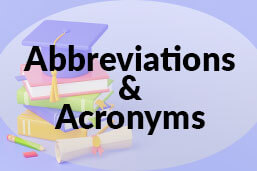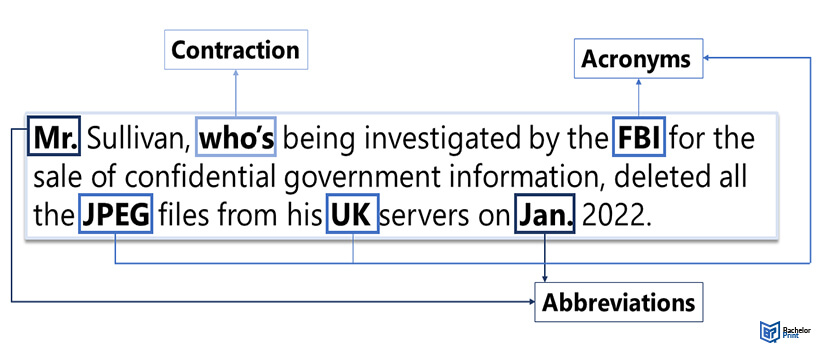
Abbreviations and acronyms have been a definitive part of our grammar for several decades, with abbreviations used as early as the 15th century. Abbreviations and acronyms serve a vital role in academic writing, contributing to brevity and ease of reading. However, their appropriate use requires understanding and consideration, as misuse can hinder clarity and cause confusion in the communication of scholarly ideas. Effective use ensures clarity and conciseness.
Definition: Abbreviations and acronyms
While sometimes thought interchangeable, abbreviations and acronyms are not the same things. Even though they do have some overlap, abbreviations and acronyms also have distinct differences.
| Abbreviations | Shortened forms of words and phrases used in place of the entire word |
| Acronyms | Words formed from the first letters of each word in a phrase. |
While acronyms are classified as abbreviations, not all abbreviations are acronyms.
The sentence below contains abbreviations and acronyms, whereas all the underlined phrases in the sentence below are abbreviations.

Abbreviations and acronyms
Abbreviations and acronyms shorten phrases in speech and writing to take up less space and save time when writing.
Some people think that abbreviations and acronyms are interchangeable. However, abbreviations and acronyms have distinct differences and different ways to identify each.
Acronyms
Acronyms are types of abbreviations that combine the first letters of each word to shorten a phrase. Acronyms are spoken and written in different ways, including:
| Type |
Acronym |
| Pronounced as words containing only the initial letters | • NATO (North Atlantic Treaty Organization) • UNESCO |
| Pronounced as words containing non-initial and initial letters | • Amphetamine (alpha-methyl-phenethylamine) • Radar (radio detection and ranging) |
| Pronounced as individual letters | • ATM • CIA |
| Pronounced as both words and letters | • JPEG • IUPAC |
| Pronounced as a string of letters with a shortcut | • AAA (Triple A) • IEEE (I triple-E) |
Introducing acronyms
Introducing abbreviations and acronyms helps the reader follow along with your work easily. The first time you use abbreviations and acronyms, introduce them by putting them in parentheses after writing out the full term. Afterward, you can stick to only using the acronym.
A list of abbreviations and acronyms is typically added after the table of contents with the complete abbreviated phrases. Even if you include a list of abbreviations and acronyms, ensure that you have fully introduced all abbreviations and acronyms the first time they appear in the text.
When the acronym is fully spelled out, you do not need to capitalize the words unless they are proper nouns.
Latin abbreviations
Although Latin is no longer the standard international language for scholars, you can still find pieces of the language in academic and non-academic writing.
Some of the general rules for applying Latin abbreviations include:
- The MLA style, Chicago style, and APA style manuals recommend that you keep abbreviations from the main body of a text.
- You can use some abbreviations in the body of a text in parentheses, but constrain the rest to tables, footnotes, and endnotes.
- However, in the APA style, you can use the abbreviation (v.) in court case titles (et al.) in discussing work by multiple authors.
Some of the most commonly used Latin abbreviations are:
| Abbreviation | Meaning |
Function |
Example |
| e.g. (exempli gratia) | For example | Used to give an example to clarify the preceding idea | Countries in Sub-Saharan Africa (e.g., Malawi and Zimbabwe) have multiple ethnicities. |
| ca. (circa) | Approximately | Used with dates to show an approximate time | Daniel Napier lost the standing diamond ca. 1876 |
Punctuating abbreviations
Abbreviations are shortened forms of words and are formed using a word’s most recognizable letters to make them easy to remember.
The guidelines below discuss when to use periods in an abbreviation:
- Use only one period when an abbreviation is at the end of a sentence.
- However, if the sentence is framed as a question, place the question mark after the period.
When abbreviating names, use a single letter followed by a period. If two consecutive letters have been abbreviated, do not include a space between the periods.
Use periods in most abbreviations with lowercase letters.
In US English, periods are necessary at the end of standard abbreviations, while in UK English, periods are not necessary at the end.
numerous advantages for Canadian students:
- ✓ 3D live preview of your configuration
- ✓ Free express delivery for every order
- ✓ High-quality bindings with individual embossing

Contractions
A contraction is a phrase or a word that has been shortened by dropping some letters. It is usually a combination of two or more words that form a new but shorter word.
Contractions shorten words, making them faster and easier to say and write. Even though contractions represent multiple words, they act as a single word.
All contractions must have an apostrophe. The apostrophe replaces letters in the original words that are not in the contraction.
Below are some brief guidelines on using contractions in your writing:
1. Avoid contractions in formal writing!
- Contractions are often used to contribute to a casual and conversational tone.
- They often seem out of place in formal writing, such as reports and academic writing.
2. Avoid double contractions when writing!
- While double contractions are generally acceptable in casual conversations, you should avoid them in all forms of writing.
- An example of a double contraction is “mustn’t’ve” in place of must not have.
Some of the common contractions used in the English language include:
| Full words |
Contraction |
| I am | I'm |
| That is | That's |
| Let us | Let's |
FAQs
While abbreviations and acronyms sound pretty similar, they have some distinct differences.
An abbreviation is a shortened form of a word used to represent the whole word, while an acronym is a shortened phrase using the first letters of the word.
The grammar rules vary for abbreviations and acronyms depending on the English variant.
You must always use a period after an abbreviation in American English, while in British English, there is typically no period after an abbreviation.
Since contractions are casual and informal, avoid using them in formal writing, such as academic papers and reports.
With a few exceptions, most style guides agree that you should avoid using Latin abbreviations in the main body of a text.
